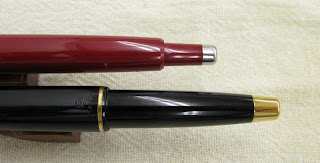An italic nib –we all know— is a nib whose line is thin on the horizontal strokes and broad on the vertical ones. And its edges are sharp, the theory goes, to ensure clear and well-defined lines.
Currently not many companies market italic nibs. Most of those sell calligraphy sets composed by several italic nibs of different widths. In a more expensive range, Pelikan has recently released a Souverän M800 with a 1.5 mm italic nib marked as IB.
 Handwritten sample with one of the Parallel Pens. I used a standard ink —Waterman's Florida Blue— instead of the dedicated Parallel-Pen ink.
Handwritten sample with one of the Parallel Pens. I used a standard ink —Waterman's Florida Blue— instead of the dedicated Parallel-Pen ink.Pilot offers the models Plumix –in the American market— and Pluminix –in Europe— with medium italic nibs of about 1 mm wide. But those are not sold in Japan. The closest to an italic are a stub and a three-tine music nibs in some of the Pilot Custom models. These two nibs have their edges polished and are fairly smooth in their writing.

The alternative, for italic writing, Pilot offers is the Parallel Pen. Apparently, these pens are very different to a fountain pen. Instead of a cylindrical or conical nib with a slit, the writing element in a Parallel Pen is composed by two thin plates that drive the ink to the lower flat end. The feeding system, however, is the same for a fountain pen and a parallel pen. And both use water-based ink.
Parallel Pens come in four sizes –1.5, 2.4, 3.8, and 6.0 mm. All of them are smooth and wet writers. The creative possibilities, endless. Especially for those touched with any artistic ability, which is not my case. These pens, however, can hardly become daily writers.
 All four Parallel Pens. On the picture, only the red ink is specific for these pens. Yellow and green are Sailor's, and blue is Waterman's. Note how the pen with yellow ink became contaminated with red ink simply by writing on top of the later.
All four Parallel Pens. On the picture, only the red ink is specific for these pens. Yellow and green are Sailor's, and blue is Waterman's. Note how the pen with yellow ink became contaminated with red ink simply by writing on top of the later.Pilot claims that the ink they provide is specific for these pens. They offer a selection of twelve colors in standard Pilot ink cartridges. All of them, they say, mixable. But despite these warnings, I have tried other inks –Waterman and Sailor in particular— in these pens with very good results. Now, intermixing them might be an issue. We know by now, though, that all Sailor inks –save the obvious exceptions of the pigmented black Kiwa Guro and blue-black Sei Boku— could be mixed.

Each of the pens comes in a plastic box that includes two cartridges –black and red—, a Pilot converter, and a cleaning sheet. The instructions say that the converter is only for cleaning purposes… Well, they do try to sell their overpriced cartridges. But at the same time, cartridges provide too little ink for these ink guzzlers. Then, a look at the barrel shows it is made entirely in plastic and the pen could easily be transformed into an eyedropper.













































